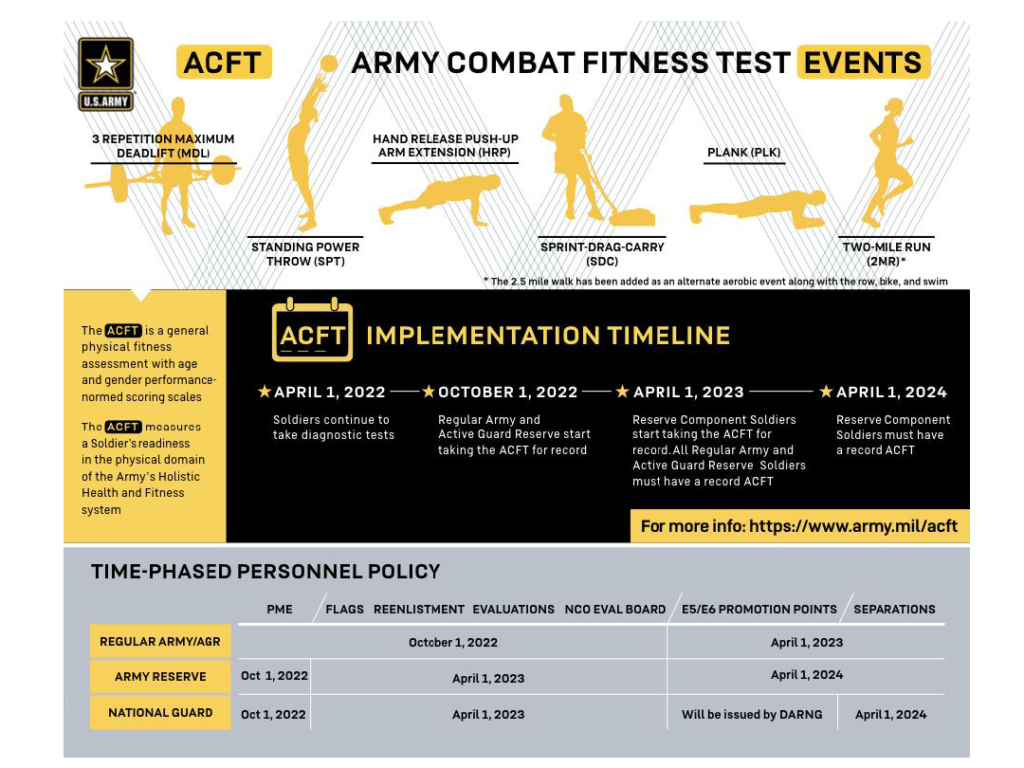
With the release of the fourth installment, ACFT 4.0, many have been curious about what’s new and what remains unchanged.
The Army’s commitment to its soldiers’ health and physical readiness is evident in its continuous efforts to improve the Army Combat Fitness Test (ACFT).
New ACFT 4.0: Key Changes
Gender- and age-adjusted ACFT scoring scales
- New Scoring Scales Introduced: The ACFT Score Chart 2024 is now performance-normed based on gender and age groups, ensuring a more inclusive and representative scoring system.
- Plank as a Leg Tuck Alternative: The plank exercise has been approved as a scoreable alternative to the leg tuck, providing soldiers with flexibility in their test choices.
- Modified Minimum Scores: The earlier minimum scores required for high physical demand in Military Occupational Specialties (MOS) are no longer applicable.
For a comprehensive understanding of these modifications, Army Directive 2022-05 (Army Combat Fitness Test) offers a detailed overview.
Reasons Behind the New ACFT 4.0 Changes
The RAND Corporation conducted an independent study on implementing the ACFT across the Army’s diverse demographic and geographic contexts.
Combining the RAND study and the Army’s analysis of nearly 630,000 test scores led to the introduction of age and gender performance-normed scoring scales in the new ACFT 4.0.
What is unchanged in ACFT 4.0?
Some items have remained unchanged with the New ACFT 4.0 Standards, as follows:
- Comparison with the APFT: The ACFT 4.0 standards reflect essential fitness metrics more accurately than their predecessor, the APFT. However, it is costlier and requires more time.
- Test Components: The test still consists of six events:
- Maximum Dead Lift (MDL)
- Standing Power Throw (SPT)
- Hand-release Push-Up (HRP)
- Sprint/Drag/Carry (SDC)
- The Plank (Newly Introduced)
- 2-Mile Run (2MR)
The Future of ACFT
Timeline and Evaluation of ACFT 4.0
- RA and USAR (AGR) Soldiers: As per ACFT 4.0, soldiers should take their first record ACFT before April 1, 2023.
- ACFT Scoring: Soldiers must score at least 60 points in each test event and receive a “GO” on the alternate aerobic event to pass. A score below 60 in any event or failing the alternate aerobic event results in a test failure.
- Diagnostic Tests and Records: RACE, USAR (AGR), and RC soldiers have specific diagnostic New ACFT 4.0 timelines, after which they may choose to have their results registered as official records.
- Evaluation Reports: The Army will mention ACFT statuses in officer and noncommissioned officer reports starting October 1, 2022.
Profiles and Alternate Events
- Soldiers with permanent profiles will attempt all events that aren’t restricted.
- Alternate aerobic events will be available for those who can’t complete the 2-mile run.
- Soldiers on temporary profiles will focus on recovery before attempting the ACFT 4.0 standards.
A Deep Dive: The Plank vs. the Leg Tuck
Initial ACFT data reveals a strong correlation between high performance in the leg tuck event and overall test success. This isn’t merely a coincidence.
- The early test data emphasizes the importance of a strong core or trunk in almost all physical activities, from lifting weights to rapid movement changes.
So, does the plank measure up as a worthy substitute for the leg tuck?
- Opinions are varied, and research is limited. However, mastering the plank can be a good starting point for those struggling with the leg tuck.
- The world’s leading spinal mechanics expert, Dr. Stuart McGill, suggests short and intense bouts of planking instead of longer durations, which may be harmful.
- Therefore, while the plank is beneficial, it’s essential to approach it wisely.
Conclusion
- The New ACFT 4.0 brings forward a balanced blend of tradition and modernization, ensuring the Army’s fitness standards remain high yet inclusive.
- With its continuous evolution, the test reaffirms the Army’s commitment to the well-being and readiness of its soldiers.
- Empowering Transactions: Navigating Firearms Sales with Proper Documentation - April 8, 2024
- Army PRT – Preparation and Recovery 2024 - March 18, 2024
- Active and Reserve Components 2024 - March 6, 2024
